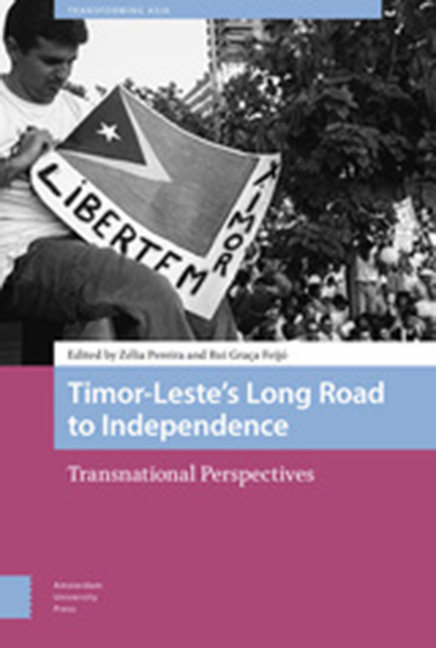Book contents
- Frontmatter
- Contents
- Acknowledgements
- A Note on the Name of the Country
- List of Figures
- Introduction: Timor-Leste’s Long Road to Independence: Outline for an Analytical Framework
- Part One Before The Portuguese Decolonisation
- Part Two The Portuguese Revolution Arrives In Timor-Leste
- Part Three Reaction To The Indonesian Invasion Of Timor-Leste
- Part Four Resisting The Indonesian Annexation Of Timor-Leste
- Index
10 - Return to Fronteira Norte: Rebuilding Resistance in Timor-Leste's Western Districts, 1990–1995
Published online by Cambridge University Press: 14 February 2024
- Frontmatter
- Contents
- Acknowledgements
- A Note on the Name of the Country
- List of Figures
- Introduction: Timor-Leste’s Long Road to Independence: Outline for an Analytical Framework
- Part One Before The Portuguese Decolonisation
- Part Two The Portuguese Revolution Arrives In Timor-Leste
- Part Three Reaction To The Indonesian Invasion Of Timor-Leste
- Part Four Resisting The Indonesian Annexation Of Timor-Leste
- Index
Summary
Abstract
The re-establishment of civilian and armed resistance in Timor-Leste's five western districts was a key accomplishment of the Timorese resistance during the 1990s. Proximity to Indonesian West Timor meant that those districts saw the highest levels of fighting and violence against civilians. High mortality, food scarcity and a leadership vacuum contributed to the near absence of resistance activities in the west during the second decade of the occupation. Under the leadership of Xanana Gusmão, the Conselho Nacional da Resistência Maubere (National Council of the Maubere Resistance, CNRM) reorganised resistance in the west in the 1990s. By 1995 both civilian cadres and armed units had wide reach and influence. This regional rebuilding played a significant role in delivering the vote for independence in the 1999 referendum. This chapter explores the shifting geography of the Resistance. It examines why resistance activity in the west dramatically decreased in the 1980s, how CNRM/ FALINTIL was able to rebuild it in the 1990s and the impact of resurgence in the west on the Resistance as a whole.
Keywords: resistance, FALINTIL, Konis Santana, Region IV, CNRM
Indonesia's twenty-four-year occupation of Timor-Leste started in October 1975 with attacks from Indonesian West Timor on Balibó, Maliana, and other border towns in Timor-Leste's Bobonaro district. A month earlier FRETILIN (Frente Revolucionária de Timor-Leste Independente/ Revolutionary Front for an Independent Timor-Leste) had assumed control after a brief but bloody civil war with rivals UDT (União Democrática Timorense/Timorese Democratic Union) and APODETI (Associação Popular Democrática Timorense/Asosiasi Demokratik Rakyat Timor/Timorese Popular Democratic Association). Indonesian troops seized northern Bobonaro, but FRETILIN's armed wing, FALINTIL (Forças Armadas de Libertação Nacional de Timor-Leste/Armed Forces for the National Liberation of Timor-Leste), bogged them down as they pushed toward Dili. The slow advance overland contributed to Jakarta's decision to launch a full air and sea invasion of Dili on December 7, 1975. From the end of 1975 through the end of 1978, the most sustained fighting and highest death tolls were in the west, defined here as Bobonaro, Covalima, Ermera, Liquiçá and Oecusse districts. Two decades later, at the end of the occupation, the west again bore the brunt of the Indonesian military's violence, particularly during the UN-administered referendum of 1999. However, during the years in between, 1980 to 1990, there was little resistance activity in the west. Resistance organisation, fighting, and Indonesian violence against civilians were concentrated in the east and centre of the country.
- Type
- Chapter
- Information
- Timor-Leste's Long Road to IndependenceTransnational Perspectives, pp. 299 - 322Publisher: Amsterdam University PressPrint publication year: 2023



